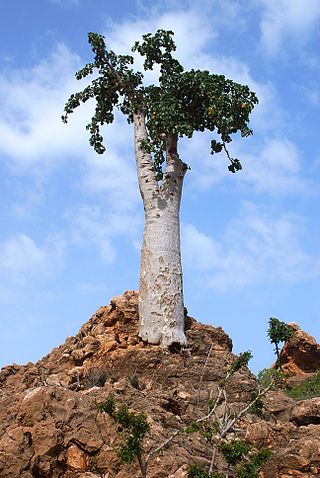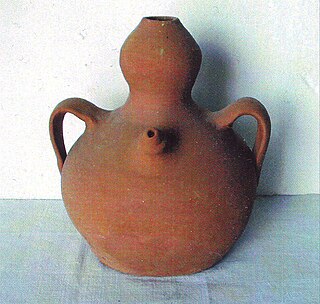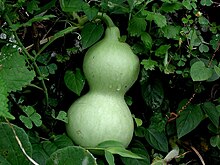
The Cucurbitaceae, also called cucurbits or the gourd family, are a plant family consisting of about 965 species in around 95 genera. Those most important to humans are the following:

A vine is any plant with a growth habit of trailing or scandent stems, lianas, or runners. The word vine can also refer to such stems or runners themselves, for instance, when used in wicker work.

Gourds include the fruits of some flowering plant species in the family Cucurbitaceae, particularly Cucurbita and Lagenaria. The term refers to a number of species and subspecies, many with hard shells, and some without. One of the earliest domesticated types of plants, subspecies of the bottle gourd, Lagenaria siceraria, have been discovered in archaeological sites dating from as early as 13,000 BCE. Gourds have had numerous uses throughout history, including as tools, musical instruments, objects of art, film, and food.

Cucurbita is a genus of herbaceous fruits in the gourd family, Cucurbitaceae, native to the Andes and Mesoamerica. Five edible species are grown and consumed for their flesh and seeds. They are variously known as squash, pumpkin, or gourd, depending on species, variety, and local parlance. Other kinds of gourd, also called bottle-gourds, are native to Africa and belong to the genus Lagenaria, which is in the same family and subfamily as Cucurbita, but in a different tribe. These other gourds are used as utensils or vessels, and their young fruits are eaten much like those of the Cucurbita species.

A melon is any of various plants of the family Cucurbitaceae with sweet, edible, and fleshy fruit. The word "melon" can refer to either the plant or specifically to the fruit. Botanically, a melon is a kind of berry, specifically a "pepo". The word melon derives from Latin melopepo, which is the latinization of the Greek μηλοπέπων (mēlopepōn), meaning "melon", itself a compound of μῆλον (mēlon), "apple", treefruit " and πέπων (pepōn), amongst others "a kind of gourd or melon". Many different cultivars have been produced, particularly of cantaloupes.

Calabash, also known as bottle gourd, white-flowered gourd, long melon, birdhouse gourd, New Guinea bean, Tasmania bean, and opo squash, is a vine grown for its fruit. It can be either harvested young to be consumed as a vegetable, or harvested mature to be dried and used as a utensil, container, or a musical instrument. When it is fresh, the fruit has a light green smooth skin and white flesh.

The koteka, also referred to as a horim or penis gourd, is a penis sheath traditionally worn by native male inhabitants of some ethnic groups in New Guinea to cover their penises. The koteka is normally made from a dried-out gourd, Lagenaria siceraria, although unrelated species such as pitcher-plant are also used. The koteka is held in place by a small loop of fiber attached to the base of the koteka and placed around the scrotum. A secondary loop placed around the chest or abdomen is attached to the main body of the koteka.

Cucurbita ficifolia is a species of squash, grown for its edible seeds, fruit, and greens. It has common names including Asian pumpkin, black seed squash, chilacayote, cidra, fig-leaf gourd, and Malabar gourd. Compared to other domesticated species in its genus, investigators have noted that samples of C. ficifolia from throughout its range are relatively similar to one other in morphology and genetic composition. Variations do occur in fruit and seed color, some isozymes, and photoperiod sensitivity.

Trichosanthes cucumerina is a tropical or subtropical vine. Its variety T. cucumerina var. anguina raised for its strikingly long fruit. In Asia, it is eaten immature as a vegetable much like the summer squash and in Africa, the reddish pulp of mature snake gourd is used as an economical substitute for tomato. Common names for the cultivated variety include snake gourd, serpent gourd, chichindapadwal and Snake Tomato.
Calabash, Lagenaria siceraria, is a vine grown for its fruit.

Kanpyō, sometimes romanized and pronounced kampyō, are dried shavings of Lagenaria siceraria var. hispida, a variety of calabash gourd. The gourd is known as yugao or fukube in Japanese. Kanpyō is an ingredient in traditional Edo style Japanese cuisine. Cooked and flavored kanpyō is commonly used in futomaki sushi roll.

Crescentia cujete, commonly known as the calabash tree, is a species of flowering plant native to the Americas, that is grown in Africa, Central America, South America, the West Indies and extreme southern Florida. It is the national tree of St. Lucia. It is a dicotyledonous plant with simple leaves, which are alternate or in fascicles (clusters) on short shoots. It is naturalized in India. The tree shares its common name with that of the vine calabash, or bottle gourd.

Luffa acutangula is a cucurbitaceous vine that is commercially grown for its unripe fruits as a vegetable. Mature fruits are used as natural cleaning sponges. Its fruit slightly resembles a cucumber or zucchini with ridges. It ranges from central and eastern Asia to southeastern Asia. It is also grown as a houseplant in places with colder climates. English common names include angled luffa, Chinese okra, dish cloth gourd, ridged gourd, sponge gourd, vegetable gourd, strainer vine, ribbed loofah, silky gourd, silk gourd,

Dendrosicyos is a monotypic genus in the plant family Cucurbitaceae. The only species is Dendrosicyos socotranus, the cucumber tree. The species is endemic to the island of Socotra in Yemen, and is the only species in the Cucurbitaceae to grow in a tree form. The species name was originally spelled D. socotrana, but this is corrected to masculine grammatical gender according to the International Code of Nomenclature for algae, fungi, and plants.

Lagenaria sphaerica is a herbaceous climber in the family Cucurbitaceae. It is commonly known as the wild melon.

Diaphania indica, the cucumber moth or cotton caterpillar, is a widespread but mainly Old World moth species. It belongs to the grass moth family, and therein to the large subfamily Spilomelinae. This moth occurs in many tropical and subtropical regions outside the Americas, though it is native to southern Asia; it is occasionally a significant pest of cucurbits and some other plants.

The Cucurbitoideae are a subfamily of the flowering plant family Cucurbitaceae (gourds). The Cucurbitaceae are divided into two subfamilies, the Zanonioideae, probably a paraphyletic group of remainders, and the well-supported monophyletic Cucurbitoideae.
Cucurbita galeottii is a plant species of the genus Cucurbita. It is native to Oaxaca, Mexico. It has not been domesticated. There is very little known about this species. Nee reports that the species is a xerophyte and that Bailey only saw the species in photographs. It is only known from specimens that "lack roots, female flowers, fruits and seeds".

A shepherd's gourd (also shepherd's jug} is a container for carrying and holding water, which has a gourd-like body, like the ordinary botijo. It has a widened neck that, allows a rope to be tied to hold it to allow it to be carried or tied to another object. Originally it consisted of a small gourd whose interior was emptied and cured, to serve as a vessel for liquids. The shape was later copied by potters in the various shapes of vessels, such as botijillas or canteens. Together with the pilgrim's scallop, it is part of the iconography of the pilgrim in general and of the Way of Saint James.


















